
This is a presentation on blogging with AI generated images and a video with proper attribution.
- Subject:
- Educational Technology
- Material Type:
- Lecture Notes
- Author:
- sushumna Rao
- Date Added:
- 03/12/2024

This is a presentation on blogging with AI generated images and a video with proper attribution.

Importance of SIne wave Boost Inverter for standalone power applications.

Student teams creatively construct mobiles using hangers and assorted materials and objects while exploring the principles of balance and center of mass. They build complex, free-hanging structures by balancing pieces with different lengths, weights, shapes and sizes.

The goal of this unit is that the students will be able to:
1. work in a blended learning environment to understand climate change and its impact on the world.
2. master a basic understanding of climate change
3. work in groups to research focused questions, present their research, and propose a way to combat climate change.
4. present their completed projects to their classmates. This unit is based on a lesson plan from The Learning Network found here: http://learning.blogs.nytimes.com/2015/04/22/guest-post-climate-change-questions-for-citizen-scientists/

This resource will help you in creating questions in gift format to bulk upload questions to Moodle course question bank.

Steps to create Moodle Quiz

Creating questions in Aiken format for bulk upload in Moodle

decision making how to overcome the confusions through POWER model.

This is a simple script and storyboard sample for a H5P Drag the words activity with parts of the plant sample.

"An Introduction to Research Methodology" contain fundamantal concepts like meaning of research, characteristics of Research, Types of Research, difference between method & methodology, process of Research and sampling methods.

The job of a synthetic chemist is akin to that of an architect. While the architect could actually see the building he is constructing, a molecular architect called chemist is handicapped by the fact that the molecule he is synthesizing is too small to be seen. With such a limitation, how does he ‘see’ the developing structure? For this purpose, a chemist makes use of spectroscopic tools. How does he cut, tailor and glue the components on a molecule that he cannot see? For this purpose chemists have developed molecular level tools called Reagents and Reactions. How does he clean the debris and produce pure molecules? This feat is achieved by crystallization, distillation and extensive use of Chromatography techniques. A mastery over several such techniques enables the molecular architect (popularly known as organic chemist) to achieve the challenging task of synthesizing the myriade of molecular structures encountered in Natural Products Chemistry, Drug Chemistry and modern Molecular Materials. In this task, organic chemists are further guided by several ‘thumb rules’ that chemists have evolved over the past two centuries.

The OER Canvas is originally created by Edelsbrunner, S., Ebner, M., Lari, C., & Schön, S. (2021, December 6). Canvas for the creation of an open educational resource (OER) - OEAA version. TU Graz Educational Technology for Open Education Austria Advanced. (opens in new window)This is a translated Telugu version.The OER Canvas is aimed at university lecturers and supports them in collecting ideas for the creation of an OER (open educational resource) for teaching. The Canvas is aimed at teachers who have already had first contact with OER, but still need how-to guide in planning and creating OERs and tips and tricks to do so. Download the attachment to see the template.

This is worksheet to practice Telugu language consonants with their secondary form.
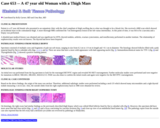
(This case study was added to OER Commons as one of a batch of over 700. It has relevant information which may include medical imagery, lab results, and history where relevant. A link to the final diagnosis can be found at the end of the case study for review. The first paragraph of the case study -- typically, but not always the clinical presentation -- is provided below.)
Patient is a 47 year old female who presented to an outpatient clinic with the chief compliant of thigh swelling due to what was thought to be a blood clot. She received a MRI scan which showed an incidental mass in the contralateral thigh. A more thorough MRI confirmed the 7cm heterogenous lesion in her left vastus intermedius. At this point of time, it was felt to be a sarcoma and a biopsy was performed.
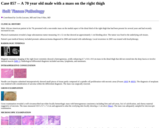
(This case study was added to OER Commons as one of a batch of over 700. It has relevant information which may include medical imagery, lab results, and history where relevant. A link to the final diagnosis can be found at the end of the case study for review. The first paragraph of the case study -- typically, but not always the clinical presentation -- is provided below.)
Male African-American patient in his 70s presented with a non-tender mass on the medial aspect of the distal third of the right thigh that had been present for several years and had recently increased in size.
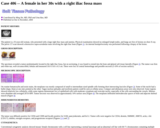
(This case study was added to OER Commons as one of a batch of over 700. It has relevant information which may include medical imagery, lab results, and history where relevant. A link to the final diagnosis can be found at the end of the case study for review. The first paragraph of the case study -- typically, but not always the clinical presentation -- is provided below.)
The patient is a 35-year-old woman, who presented with a large right iliac mass and anemia. Physical examination showed no enlarged lymph nodes, and lungs are free of lesions on chest X-ray. The pelvic CT scan showed a destructive supra-acetabular mass involving the right iliac bone (Figure 1). An internal hemipelvectomy was performed following a biopsy of the lesion.
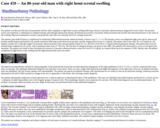
(This case study was added to OER Commons as one of a batch of over 700. It has relevant information which may include medical imagery, lab results, and history where relevant. A link to the final diagnosis can be found at the end of the case study for review. The first paragraph of the case study -- typically, but not always the clinical presentation -- is provided below.)
The patient is an 80-year-old man who presented with the chief complaint of right hemi-scrotal swelling following a history of prostatic adenocarcinoma diagnosed 8 years earlier. The prostate cancer was treated by a combination of radiation therapy and androgen deprivation therapy. Biochemical recurrence of prostatic adenocarcinoma had recently been documented prior to the onset of the swelling. Physical examination revealed a paratesticular mass that was clinically felt to be a benign hydrocele.
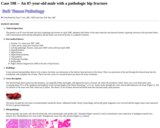
(This case study was added to OER Commons as one of a batch of over 700. It has relevant information which may include medical imagery, lab results, and history where relevant. A link to the final diagnosis can be found at the end of the case study for review. The first paragraph of the case study -- typically, but not always the clinical presentation -- is provided below.)
The patient is an 87-year-old male who had a pathology hip fracture in April 2008, admitted with failure of the open reduction and internal fixation, requiring resection of the proximal femur with reconstruction and total hip arthroplasty and the tumor was resected mostly as a palliative measure.
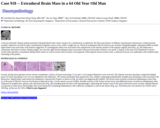
(This case study was added to OER Commons as one of a batch of over 700. It has relevant information which may include medical imagery, lab results, and history where relevant. A link to the final diagnosis can be found at the end of the case study for review. The first paragraph of the case study -- typically, but not always the clinical presentation -- is provided below.)
A 64 year old male Chinese patient presented with generalized tonic-clonic seizures for a month prior to admission. He had a past history of diabetes, hypertension and previous cerebrovascular accident. Otherwise, he had no other constitutional symptoms such as fever, chills, weight loss etc. Physical examination did not disclose any systemic lymphadenopathy. Subsequent MRI revealed right frontal extra-axial mass with features suggestive of a meningioma which was associated with compression of the anterior portion of the superior sagittal sinus (Fig. 1a). He underwent a craniotomy and tumor excision. During surgery, an avascular right frontal enplaque tumor associated with poor brain-tumor interface was noted. A biopsy of the mass was submitted for frozen section intra-operative consultation during which smears as well as frozen tissue sections were prepared. Following the frozen section result, a subtotal resection was undertaken with residual tumor remaining in the patient.
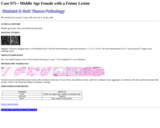
(This case study was added to OER Commons as one of a batch of over 700. It has relevant information which may include medical imagery, lab results, and history where relevant. A link to the final diagnosis can be found at the end of the case study for review. The first paragraph of the case study -- typically, but not always the clinical presentation -- is provided below.)
Middle age female with an incidental left hip lesion.